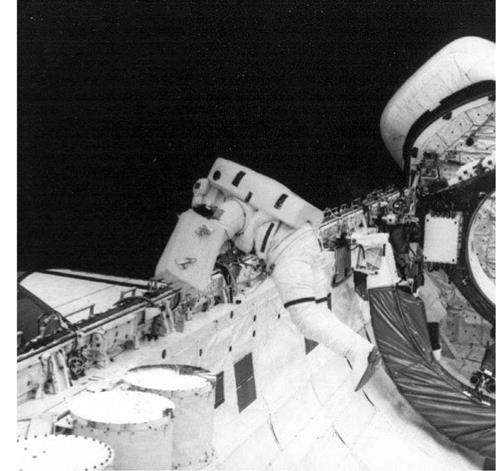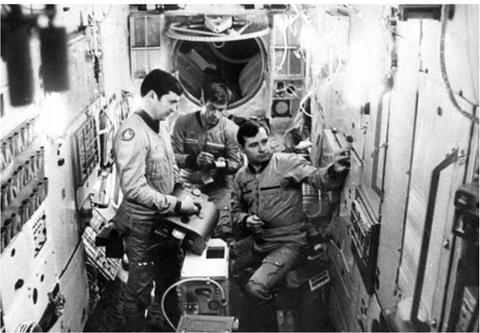STS-6
|
Int. Designation |
1983-026A |
|
Launched |
4 April 1983 |
|
Launch Site |
Pad 39A, Kennedy Space Center, Florida |
|
Landed |
9 April 1983 |
|
Landing Site |
Runway 22, Edwards Air Force Base, California |
|
Launch Vehicle |
OV-099 Challenger/ET-8/SRB A17; A18/SSME #1 2017; #2 2015; #3 2012 |
|
Duration |
5 days 0 hrs 23 min 42 sec |
|
Callsign |
Challenger |
|
Objective |
Maiden flight of OV-099 (Challenger); EVA demonstration; deployment of first TDRS |
Flight Crew
WEITZ, Paul Joseph, 50, civilian, commander, 2nd mission Previous mission: Skylab 2 (1973)
BOBKO, Karol Joseph, 45, USAF, pilot
MUSGRAVE, Franklin Story, 47, civilian, mission specialist 1
PETERSON, Donald Herod, 49, civilian, mission specialist 2
Flight Log
The first Challenger orbiter mission was originally due to have taken place on 27 January 1983 but was delayed by a series of potentially disastrous engine problems which first came to light after Challenger’s Flight Readiness Firing on 18 December
1982. Engineers detected an abnormal level of gaseous hydrogen. A second FRF was scheduled for 25 January and the TDRS payload was removed from Challenger. The hydrogen leak was detected again and this time was traced to a 2 cm (| in) crack in the No.1 main engine combustion chamber coolant outlet manifold. Engine 1 was ordered to be replaced. TDRS was replaced, only to be slightly damaged by fine salt sea spray after a severe storm. It was back inside Challenger’s cargo bay by 19 March.
Worse was to follow. The replacement engine 1 was found to be faulty and had to be replaced itself, then an inspection of the No.2 and 3 engines revealed hairline cracks which had to be repaired. Challenger sat engineless on the pad. At last, on 4 April
1983, at the comparatively late hour of 18:30 KSC time, Challenger ascended flawlessly into clear blue skies, the only anomaly being the annoying deposition of some black soot on Challenger’s windows at SRB separation.
The rookie crew (called the F Troop after a TV programme and the fact that they were the sixth Shuttle crew) proceeded to achieve the main objective – to deploy NASA’s first $100 million communications station in space, TDRS, on only the second IUS solid propellant two-stage upper stage flown. This was duly deployed
|
The first Shuttle EVA demonstration was conducted during STS-6 |
from its tilt table and was later injected into geostationary transfer orbit. A second stage failure stranded the satellite, however, and through no fault of its own the Shuttle was tarred with the same brush by some of the press. TDRS was eventually nudged into its planned geostationary orbit by careful firing of its own thrusters over a period of 58 days.
Maximum altitude reached by Challenger in the 28.4° orbit was 248 km (154 miles). On 8 April, Story Musgrave (EV1) and Donald Peterson (EV2) made the delayed EVA that was planned for STS-5, lasting 4 hours 17 minutes, to check out the Shuttle spacesuit and practice making space repairs, featuring in some spectacular TV. It was also the first US EVA since Skylab 4, nine years earlier. Later, Challenger came home to Edwards Air Force Base, landing on runway 22 at T + 5 days 0 hours 23 minutes 42 seconds, the shortest four-crew space flight.
Milestones
89th manned space flight 37th US manned space flight 6th Shuttle flight 1st flight of Challenger
16th US and 22nd flight with EVA operations
1st Shuttle-based EVA
1st TDRS deployment mission

 |
Flight Crew
TITOV, Vladimir Georgyevich, 36, Soviet Air Force, commander STREKALOV, Gennady Mikhailovich, 43, civilian, flight engineer 1, 2nd mission
Previous mission: Soyuz T3 (1980)
SEREBROV, Aleksandr Aleksandrovich, 39, civilian, research engineer, 2nd mission
Previous mission: Soyuz T7 (1982)
Flight Log
Salyut 7 remained empty during the Russian winter of 1982-3 and was joined by the unmanned Cosmos 1443 module in March. Trained to work aboard Salyut and the new module were Vladimir Titov, Aleksandr Serebrov, making the first successive national manned space flight, and Gennady Strekalov. Their attempt to dock with Salyut, however, was doomed very soon after lift-off, at 19: 11 hrs local time from Baikonur, when the payload shroud tore away Soyuz T’s rendezvous radar antenna which only partially deployed. The crew used the RCS thrusters to try to shake the antenna free but to no avail. In trying to hide the serious problem, these engine firings were reported as tests of the attitude control system.
Although mission rules would normally dictate a return to Earth, the rookie commander Titov got permission to try a visual rendezvous and attempted docking using radar readings from the ground. The docking was perceived as having a low success probability by the ground controllers. It could have been a complete disaster, for Soyuz T8 flew past Salyut 7 at great speed, missing a catastrophic collision by 160 m (525 ft). Titov had made an optically guided approach to Salyut’s rear docking port after a 50 second rocket burn. The seventh space station flight had to be aborted not because of lack of power but because propellant reserves were not high enough to try again. The difficulty in guiding the Soyuz T to the station becomes more apparent when it was later revealed by Titov that he had not trained for a fully manual docking
|
Soyuz T8 crew during a training session in the Salyut 7 mock-up, something they did not put into practice in space. L to r Titov, Serebrov, Strekalov |
approach and was unsure of his depth perception through the spacecraft periscope as he attempted a difficult manoeuvre.
The crew, which would have been the first three-man long duration crew since Soyuz 11, came home 96 km (60 miles) northeast of Arkalyk at T + 2 days 0 hours 17 minutes 48 seconds. Maximum altitude reached in the 51.6° orbit was 300 km (186 miles).
Milestones
90th manned space flight 53rd Soviet manned space flight 46th Soyuz manned space flight 7th Soyuz T manned space flight
1st space flight by crewman on successive national missions












